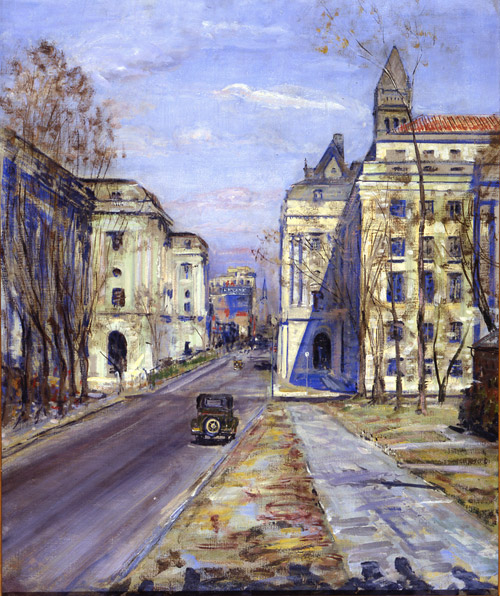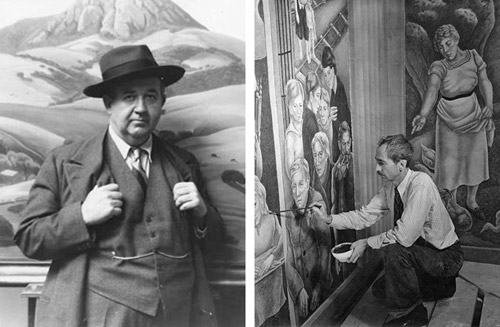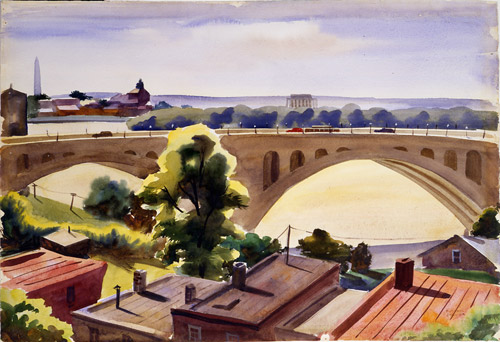During the Depression that followed the stock market crash in 1929, thousands of businesses and banks failed and a quarter of the American workforce was unemployed. An unintended benevolent consequence of the economic hardships of the times was that attendance at many American museums reached an all-time high. Having little money for anything else, the appeal of free museum admissions attracted many Americans who, for the first time, were exposed to and appreciated works of art. Through New Deal initiatives under President Franklin D. Roosevelt beginning in 1933, there was a confluence between the heightened awareness of public art, the employment relief needs of artists, and the creation of artwork for newly constructed federal buildings that resulted in three public arts programs that were administered out of the Treasury Department.

Figure 1: IRS building and Street Scene by Edwin Doniphan, 1934, Oil on canvas
“The Treasury Department has erected, or is erecting, and has control of some 2,800 buildings scattered over the United States and its insular possessions. Under the Section of Painting and Sculpture, organized by Secretary of the Treasury Morgenthau on October 16, 1934, approximately 300 of these buildings have been decorated through reservations made under the building fund of each building. With the exception of these buildings, no funds are available and it is not possible to put murals or sculpture in the remaining ones. Consequently, a request was made to the President by Mr. Edward Bruce [of the Treasury Department] on April 12, 1935, for funds from the Emergency Relief Appropriation Act of 1935-37 for a project to employ competent, unemployed artists in decorating Federal buildings where there was no money available for this decoration under the building fund. This broadens the scope of the Treasury Departments Art Program and enables the Government to obtain first-rate works of art for many of its buildings at the “going” WPA wage rate, as specified in Executive Order No. 7046. The results of this work will be a permanent and important addition to the wealth of this country. A wealth which will increase in value as time goes on and as its worth is more justly appreciated.” - Interim Report, Treasury Relief Art Project, May 1, 1936.

Figure 2: Treasury Administrator Edward Bruce (L) and artist George Biddle (R). Biddle went on to paint a series of murals at the Justice Department Building in Washington, DC (pictured here).
Much of the momentum to create and manage the arts programs at the Treasury Department were provided by artist George Biddle and Treasury administrator Edward Bruce. Biddle was a practicing artist who had traveled and lived in Europe and had worked with some of the best mural painters in Mexico. On May 9, 1933 he wrote a letter to newly elected President Roosevelt (FDR) suggesting the government create opportunities in federal buildings for American mural painters to “improve the quality of American life”. Two weeks later FDR had arranged for Biddle to meet with Treasury Assistant Secretary Lawrence Robert, Jr who oversaw the federal building construction program through the Supervising Architect’s Office.
When Biddle and Robert met in June, Biddle learned that Congress had approved funds for the decoration of the new Department of Justice and Post Office buildings in Washington, DC but they were reluctant to spend the funds on a “luxury” like art. Shortly after the meeting Biddle wrote a letter to various government officials, including First Lady Eleanor Roosevelt, proposing a “Revival of Mural Painting” in America. Mrs. Roosevelt passed the letter along to FDR who approved of the concept. Treasury Assistant Secretary Robert was also impressed with the plan as was the Justice Department building architect Charles Borie.
Within the Treasury Department, the greatest advocate of Biddle’s proposal was Edward Bruce, an expert on monetary policy who had joined Treasury in 1932 and was a good friend of Assistant Secretary Robert. In addition to his financial pedigree, Bruce was an amateur artist and enthusiastic arts advocate. In October of 1933 Bruce held a series of gatherings at his Washington home to discuss ideas for how the government could support a national arts program. While Assistant Secretary Robert and the Treasury Department supported the idea of an arts program there was not a mechanism within the department to provide a funding source. To secure funding, Bruce and Biddle met with Public Works Administrator Harold Ickes. At the meeting, Ickes supported the program and agreed that it could be funded through the Relief Administration administered by Harry Hopkins. Hopkins saw no distinction in being able to provide a relief opportunity for artists than it would be for plumbers or any other profession and allocated $1,039,000 to the arts program.

Figure 3: Bridge and Monuments by Mitchell Jamieson, Watercolor on Paper, c.1935
The Collection at the Treasury building includes 62 works of art from the New Deal WPA arts programs that operated over a ten year period from 1933 to 1943. The Works Progress Administration, Federal Art Project was the largest and the most widely known program. There is less awareness of the three WPA programs that operated directly out of the Treasury Department: The Public Works of Art Project, the Section on Painting and Sculpture and the Treasury Relief Act. The contributions of these programs remain highly visible to this day in many of the country’s federal buildings. The connection between New Deal artwork and the Treasury continues through the stewardship and display of WPA artwork in the Treasury building.
“Art in America has always belonged to the people and has never been the property of an academy or a class. The great Treasury projects, through which our public buildings are being decorated, are an excellent example of the continuity of this tradition. The Federal Art Project of the Works Progress Administration WPA is a practical relief project which also emphasizes the best tradition of the democratic spirit. The WPA artist, in rendering his own impression of things, speaks also for the spirit of his fellow countrymen everywhere. I think the WPA artist exemplifies with great force the essential place the arts have in a democratic society such as ours.” – President Franklin D. Roosevelt, May 10, 1939[1].
Summary of the four New Deal arts programs:
· Public Works of Art Project
· Section on Painting & Sculpture
· Treasury Relief Act
· Works Projects Administration Federal Art Project
The first federal art program, the Public Works of Art Project (PWAP) was a crash relief program administered without a strict relief test by the Treasury Department. The program lasted six months from December 1933 to June 1934, employing 3,700 artists at a cost of approximately $1,312,000.
The Section of Painting and Sculpture program, later called the Section of Fine Arts was created by Treasury Secretary Henry Morgenthau, Jr. and was the second federal arts program administered by the Treasury Department. It obtained paintings and sculptures through competitions to decorate new federal buildings, largely post offices and court houses. Inaugurated in October 1934, the program ended in 1943 after awarding approximately 1,400 contracts for art at a cost of $2,571,000.
The Treasury Relief Act was formed on July 21, 1935 by an initial allocation of $530,784 from the WPA to the Treasury for the decoration of federal buildings, administered under the same relief rules as the WPA. The section administering the act employed 446 people including 275 artists, 75% of whom were on relief (WPA employment rates ranged from $69 to $103 per month[2]). The cost of the program was $833,784 and was operated up until 1939.
The Work Progress Administration’s Federal Art Project (WPA/FAP) was part of a wider government program called Federal Project No. 1, which included the visual arts as well as drama, music and writing. It was started in 1935 and was administered according to the relief rules of the WPA. The program employed over 5,000 people and cost $35,000,000 lasting until June of 1943.
[1] The Franklin D. Roosevelt Presidential Library and Museum
[2] Interim Report, Treasury Relief Art Project, May 1, 1936, National Archives, Still Picture Branch, Record Group 121, Public Buildings Service
